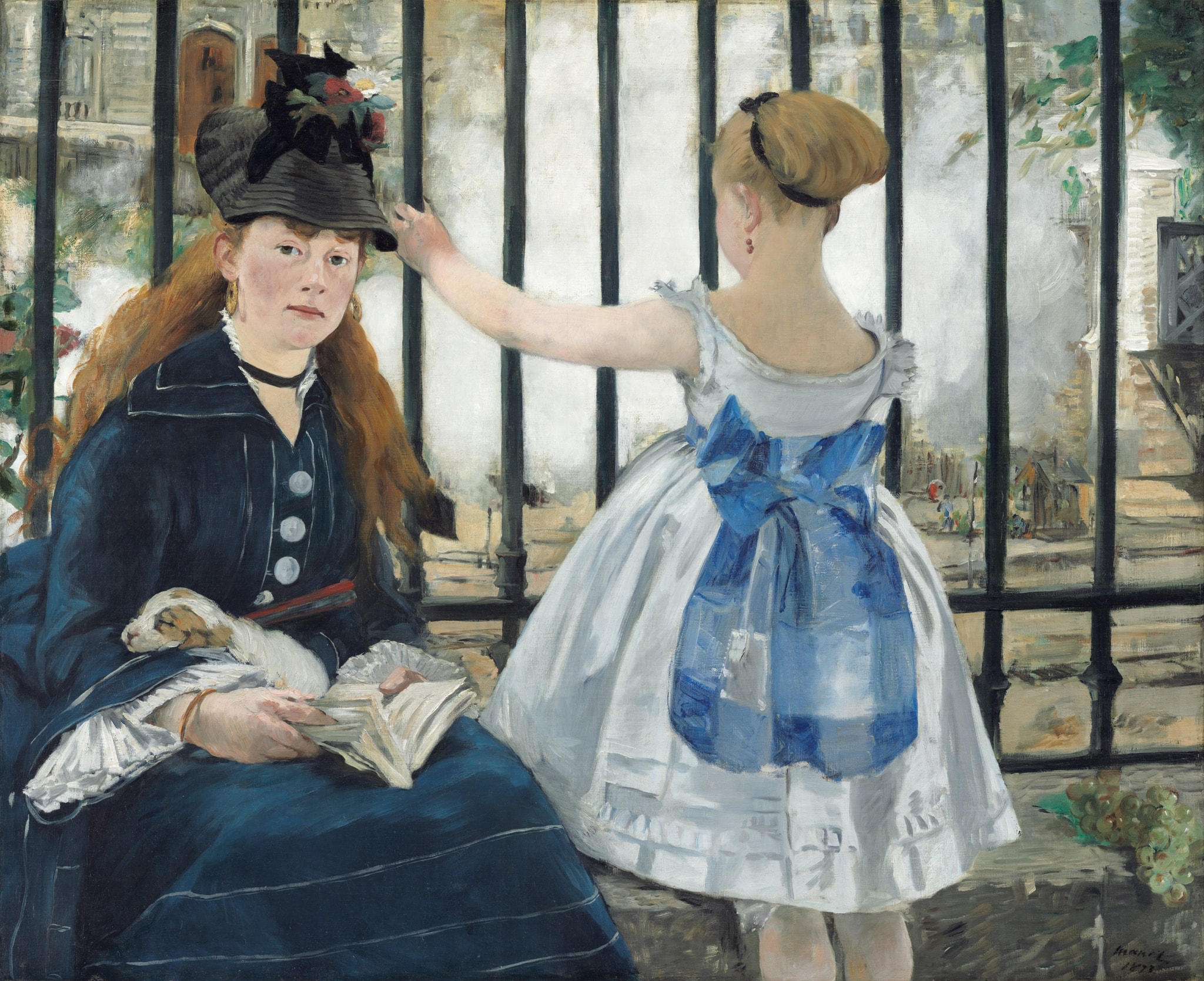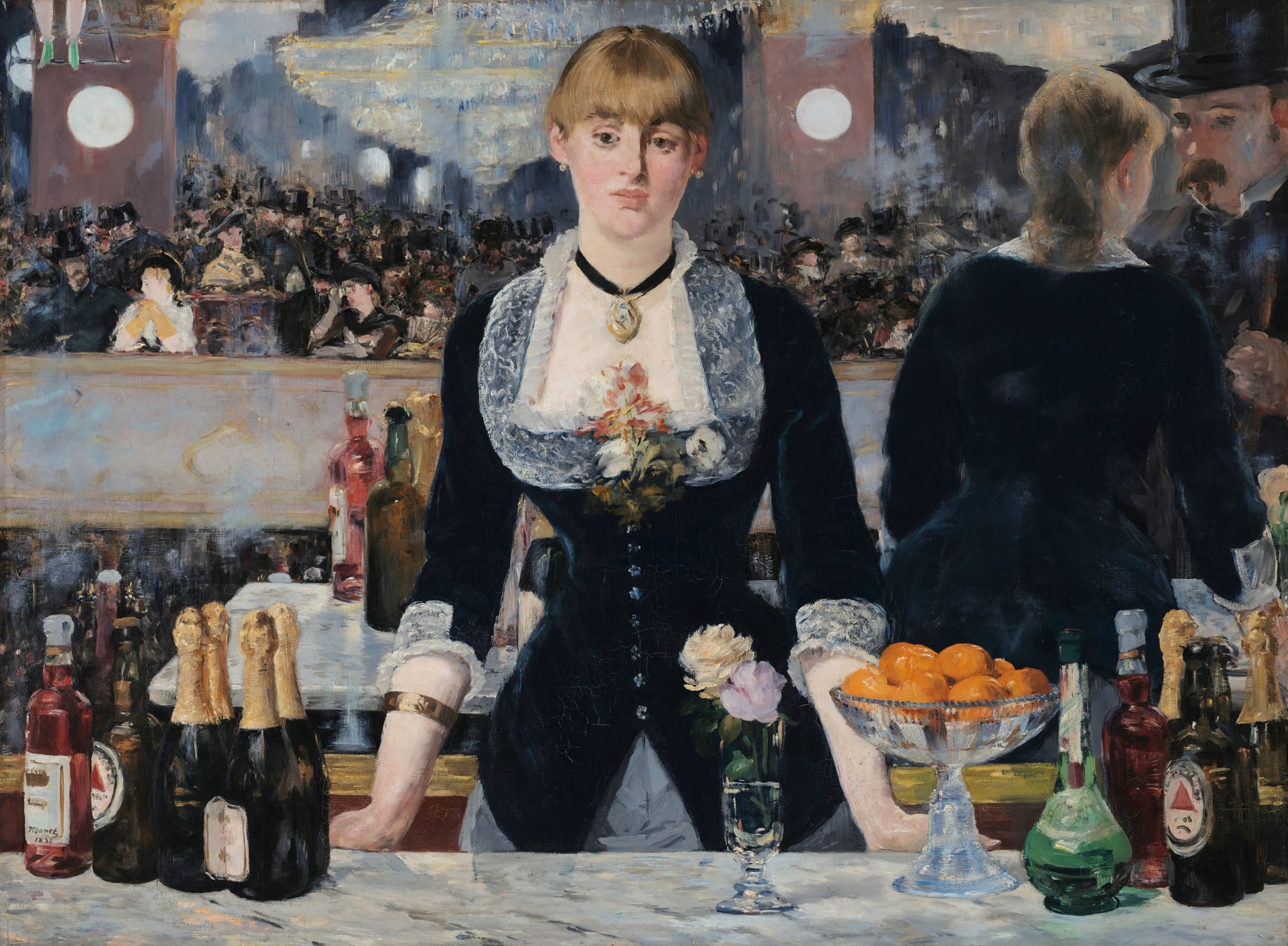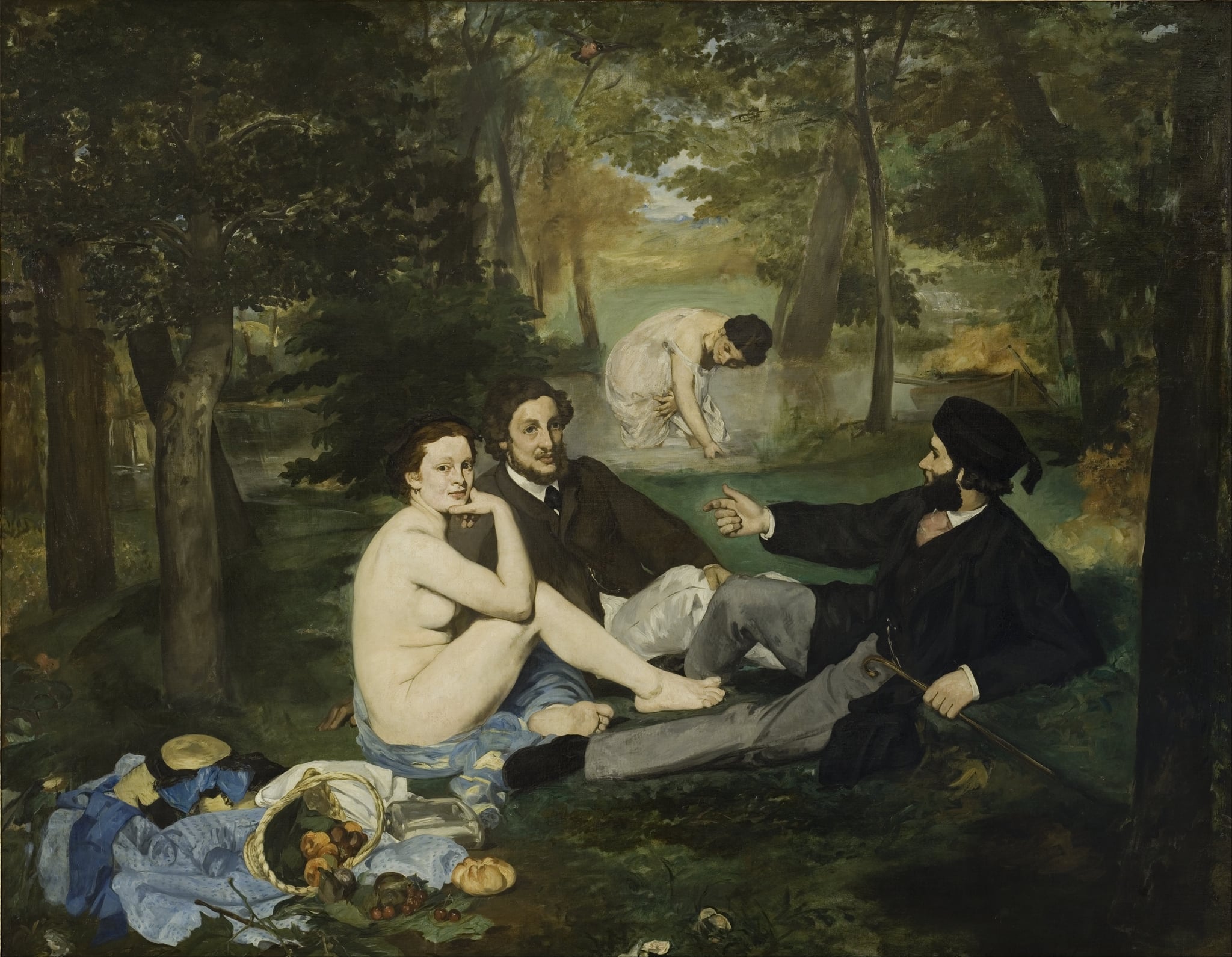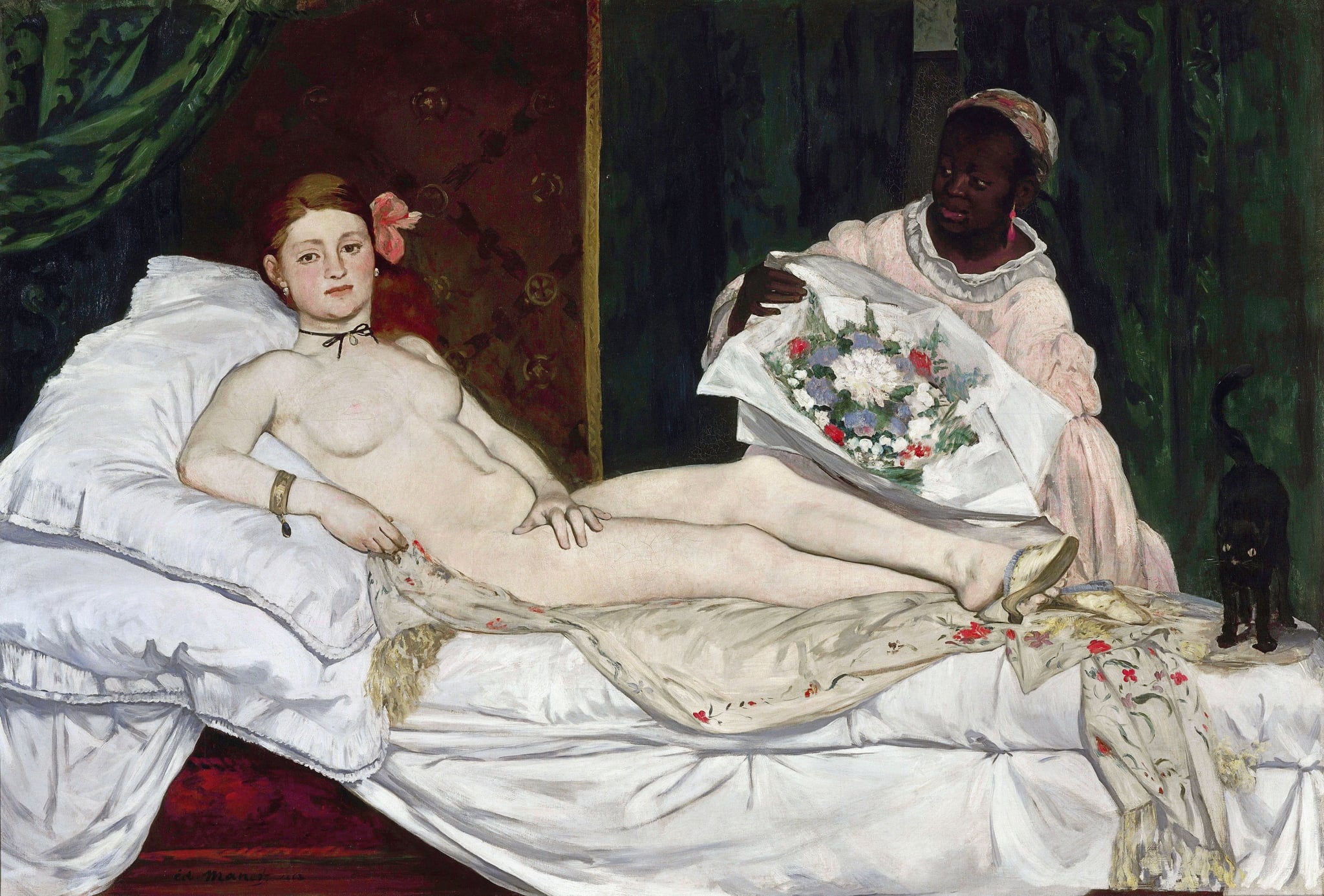The Railway
Fast Facts
- Year
- 1873
- Medium
- Oil on canvas
- Dimensions
- 93.3 × 111.5 cm
- Location
- National Gallery of Art, Washington, D.C.

Click on any numbered symbol to learn more about its meaning
Meaning & Symbolism
The meaning of The Railway lies in how Manet makes the iron fence and steam do the work of modernity—screens that both reveal and withhold, forcing us to negotiate fractured seeing. The woman’s direct, unyielding gaze refuses narrative while the child’s absorbed stance points to a future oriented toward machines and motion. This split in attention stages the new urban experience: proximity without intimacy, contact without connection 23. Why The Railway is important is that it crystalizes, at Salon scale, Manet’s modernist strategy—flattening depth, disrupting story, and making perception itself the subject—at the very moment Paris and its railways were remaking social life 14.
Manet builds the picture on deliberate counterpoints that turn a platform’s pause into a drama of modern seeing. The seated woman—identified as his familiar model Victorine Meurent—meets our gaze across the narrow ledge, her finger marking a place in the open book while a small dog slumps in her lap. Her look is neither welcoming nor explanatory; it registers an interruption and sets a boundary. Parallel to that psychological boundary runs the iron fence, its black uprights compressing space and insisting on the flatness of the picture plane. The bars are not mere scenery: they grid the canvas, cut through bodies, and literalize separation between genteel leisure above and industrial labor below, where figures flicker beyond the steam. Manet’s paint handling makes the steam the true protagonist—opaque, shape‑dissolving, and central—so that the railway is present chiefly as its vaporous effect. We see the Pont de l’Europe at the upper right and, in the upper left, the doorway that led to Manet’s own studio; the city’s infrastructure and the artist’s workplace interlock, linking aesthetic experiment to the engineered city 124. Against this scaffolding of metal and vapor, Manet stages a dual temporality. The child in the crisp white dress and oversized blue bow faces away, fingers splayed on the bars, body pitched toward the noise and novelty to come. The woman, dark‑clad with blue piping and a stylish hat, anchors the present with a calm, frontal assertion. Their color inversions—white/blue versus blue/white—echo their opposed orientations: curiosity versus composure, outward gaze versus returned look. At the lower right, a small cluster of grapes and the sagging fan beside the book hint at fleeting pleasures and seasonal time, but Manet refuses emblematic closure; he shows how modern signs circulate without fixed meanings. The “unfinished” look that bothered Salon critics—loose smoke, sketchy rails, worked‑over edges—becomes the painting’s argument: in the city, perception is contingent, contingent enough that a train can be represented by what it erases from view 13. The Railway also recasts spectatorship as a social relation marked by classed distance. The fence both protects and confines, producing the sensation of being at once inside and outside the scene, much like urban passersby catching each other’s eyes and moving on. By letting Meurent’s gaze hold us while withholding narrative, Manet replaces story with encounter—an ethics of looking where recognition does not guarantee understanding. This is why the painting matters historically: exhibited at the 1874 Salon, the same spring that the Impressionists launched their first group show, it stakes a modernist claim from within official culture. Manet embraces everyday life yet refuses anecdote; he records the industrial city yet turns steam, iron, and interrupted attention into pictorial form. In The Railway, modernity is not just what is pictured; it is how the picture makes us look—through bars, through vapor, through another person’s steady, resistant eyes 123.Citations
- National Gallery of Art, The Railway (object page and essays)
- National Gallery of Art – The Railway (overview and Look Closer)
- Smarthistory, Manet, The Railway
- Juliet Wilson‑Bareau, Manet, Monet, and the Gare Saint‑Lazare (NGA/Yale monograph)
- Encyclopaedia Britannica, Édouard Manet
- T. J. Clark, “Modernism, Postmodernism, and Steam,” October 100 (2002)
- Robert L. Herbert, Impressionism: Art, Leisure, and Parisian Society (1988)
- Harry Rand, Manet’s Contemplation at the Gare Saint‑Lazare (1987)
Explore Deeper with AI
Ask questions about The Railway
Popular questions:
Powered by AI • Get instant insights about this artwork
Interpretations
Historical Context
Source: National Gallery of Art; Smarthistory; Juliet Wilson‑Bareau
Formal Analysis
Source: National Gallery of Art; T. J. Clark (October)
Social Commentary
Source: Robert L. Herbert; National Gallery of Art; Smarthistory
Psychological Interpretation
Source: Harry Rand; National Gallery of Art
Symbolic Reading
Source: Harry Rand; Smarthistory; National Gallery of Art
Reception History
Source: National Gallery of Art; Smarthistory; Juliet Wilson‑Bareau; T. J. Clark
Related Themes
About Édouard Manet
More by Édouard Manet

A Bar at the Folies-Bergère
Édouard Manet (1882)
Édouard Manet’s A Bar at the Folies-Bergère stages a face-to-face encounter with modern Paris, where <strong>commerce</strong>, <strong>spectacle</strong>, and <strong>alienation</strong> converge. A composed barmaid fronts a marble counter loaded with branded bottles, flowers, and a brimming bowl of oranges, while a disjunctive <strong>mirror</strong> unravels stable viewing and certainty <sup>[1]</sup><sup>[2]</sup>.

Luncheon on the Grass
Édouard Manet (1863)
Luncheon on the Grass stages a confrontation between <strong>modern Parisian leisure</strong> and <strong>classical precedent</strong>. A nude woman meets our gaze beside two clothed men, while a distant bather and an overturned picnic puncture naturalistic illusion. Manet’s scale and flat, studio-like light convert a park picnic into a manifesto of <strong>modern painting</strong> <sup>[1]</sup><sup>[2]</sup>.

Olympia
Édouard Manet (1863 (Salon 1865))
A defiantly contemporary nude confronts the viewer with a steady gaze and a guarded pose, framed by crisp light and luxury trappings. In Olympia, <strong>Édouard Manet</strong> strips myth from the female nude to expose the <strong>modern economy of desire</strong>, power, and looking <sup>[1]</sup><sup>[3]</sup>.